In our last few blog posts, we’ve talked about customer segmentation and different ways to segment your target audience into smaller chunks like demographic and psychographic segmentation to connect with the right people. Customer segmentation enables marketers to focus their marketing efforts on their target customers, improving their marketing targeting strategy.
But what if there was a subset of users that had an even bigger impact when targeted? Enter Super Users – the strategic players who can give your ROI numbers a major boost! It may take some trial-and-error testing to pinpoint these super segments accurately, but knowing how these key individuals interact is essential for any successful marketing targeting strategy.
What is a Super User?
As technology progresses and media consumption grows, a unique group is rising to the top.
Activate Consulting’s Technology & Media Outlook 2023 found that Super Users are powering the digital world, with a strong presence across all major media and technology verticals. This select crowd is made up of young, educated individuals who lead affluent lifestyles – spending more time and money than any other user group!
Why should you add Super Users to your marketing targeting strategy?
Super Users are a highly influential audience with the potential to drive major business growth. They stand out from other users in their commitment and dedication across four key areas:
- Time spent with media
- Spend
- Technology and media adoption
- Emerging eCommerce behaviors
“Over the next years, the imperative for technology and media companies will be to identify, reach, and super-serve Super Users – the single group of power users whose time and spend far surpass those of other users.”
Activate consulting’s technology & media outlook 2023
You can use Super Users as a subset of your marketing targeting strategy. While you may need to reach beyond Super Users to achieve your goals, it’s worthwhile to consider:
- Targeting them separately
- Spending more on media
- Reaching them at a higher frequency
Time spent with media
Super Users make a powerful impact, despite comprising only 22% of the U.S. population. They are incredibly influential in terms of media consumption and engagement – spending more than double the amount of time interacting with content compared to other users.
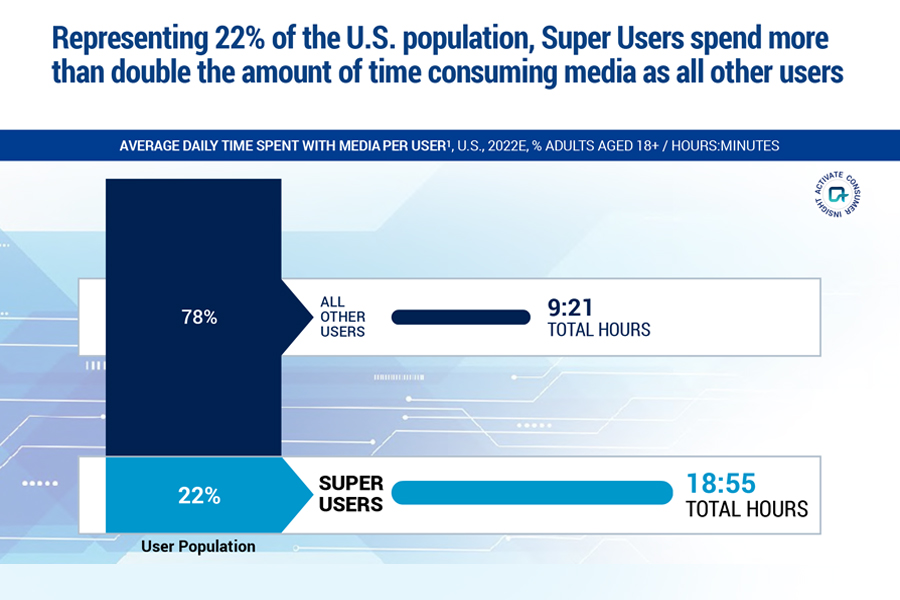
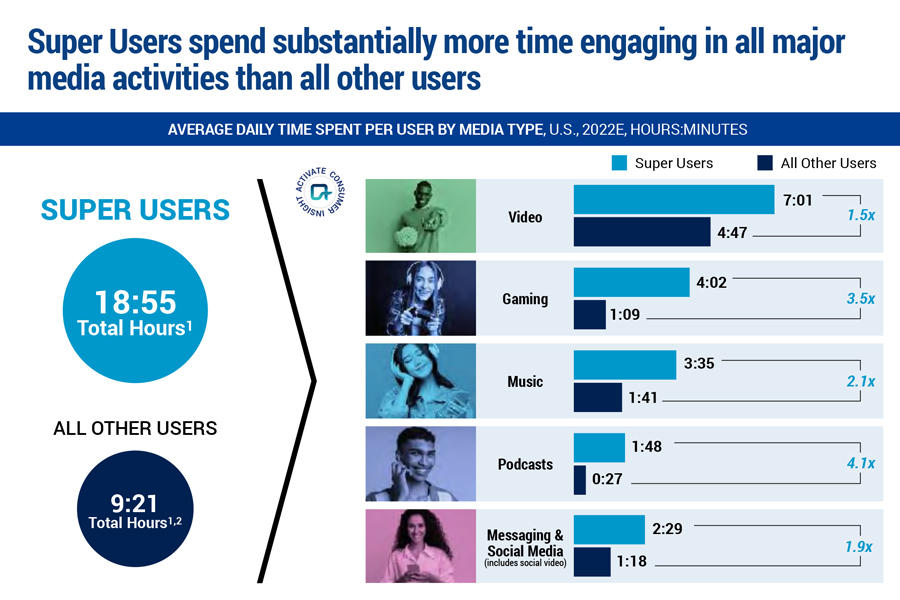
Inclined to multitask
Super Users take multitasking to the next level. Not only do they spend more time with electronics, but they excel in the art of juggling multiple activities. While watching videos and playing video games on one device, Super Users might also be busy engaging with social media on another. This makes them an unstoppable force when it comes to getting the most out of their digital experiences!

High share of dollar spend
Super Users are big spenders when it comes to media, particularly in gaming and music. Compared with all other users, Super Users’ average video spend is close to triple the amount ($76 vs $27). However, their biggest increases come from gaming and music; they’re collectively spending 12x more on games and shelling out 21x as much for tunes!
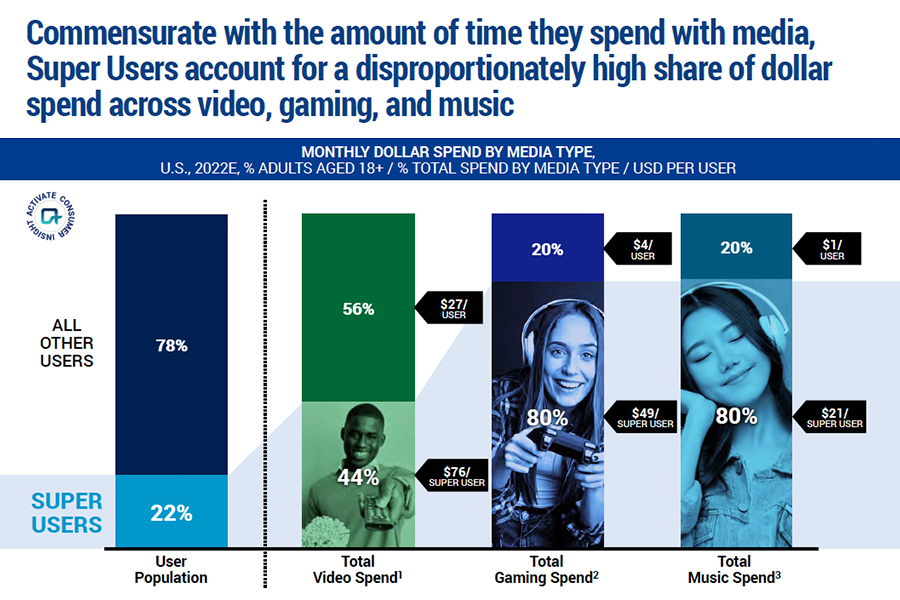
With 60% of eCommerce spend coming from Super Users, they are driving the industry forward with their enthusiasm and willingness to test out cutting-edge shopping trends like buying through social media, live streaming purchases, and trying on products virtually. Super Users are setting the tone for this dynamic industry.
Technology and media adoption
Most Super Users are brand advocates. They’re trendsetting individuals who stay ahead of the curve on media and technology. They eagerly take advantage of new products, services, and data-sharing opportunities to receive tailored ads that fit their lifestyle.
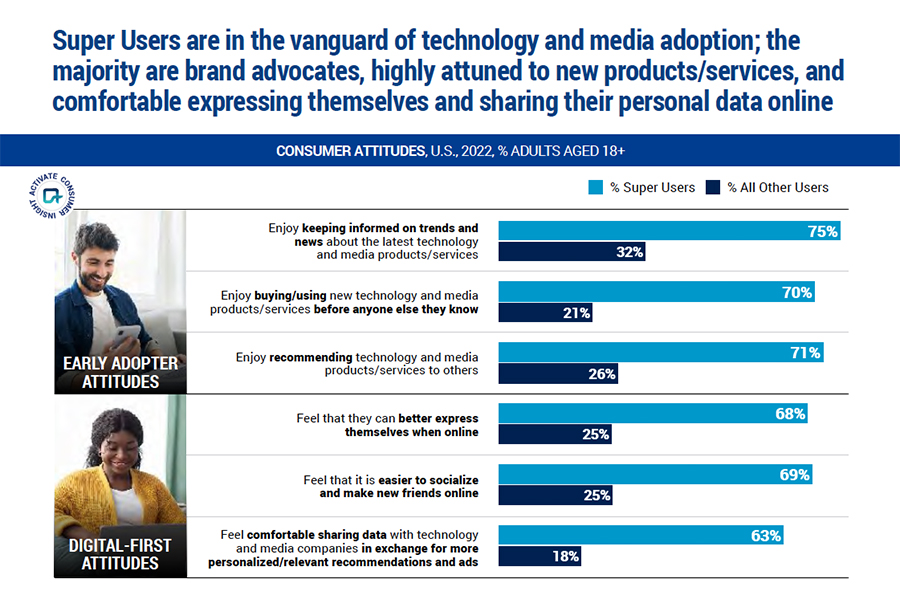
Crypto & NFTs
Super Users blaze the trail for cryptocurrency and non-fungible tokens (NFTs)! This group is five times more likely to explore, engage with, and embrace new digital-monetary technologies.
Pioneers of the Metaverse
As Metaverse usage continues to rise, Super Users are leading the way. Over 80% of these trailblazers have embraced these digital spaces within just the last year. We’re seeing accelerated interest from them as they seek out new opportunities for creativity, connections, and transactions within their favorite Metaverses. Many express interest in Metaverse experiences such as purchasing physical items to creating virtual havens. In fact, they’re 5x more interested in all things meta-related!
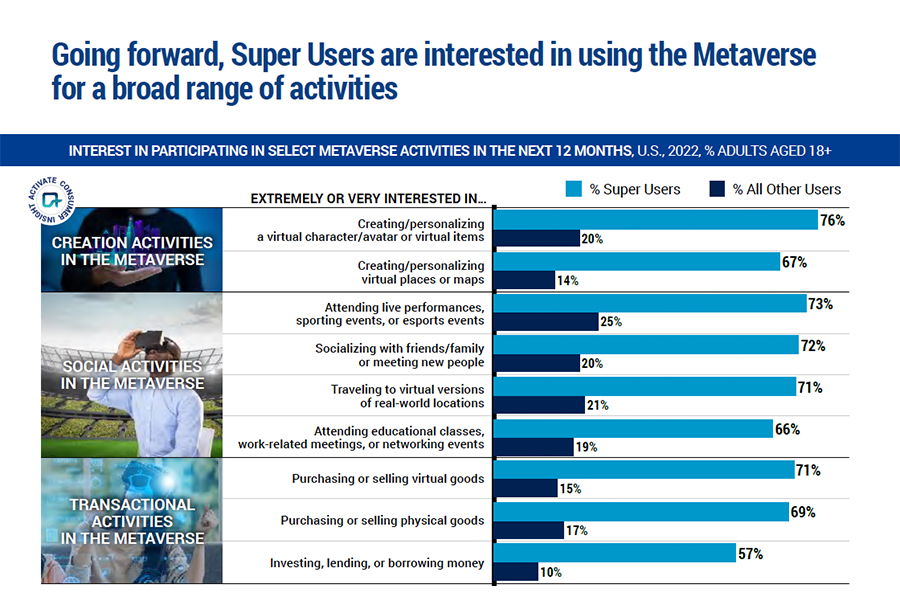
How Experian can help you identify and target Super Users
So how can you find your Super Users and include them in your marketing targeting strategy? Whether you want to build or acquire highly addressable audiences, we can help you precisely reach the right individuals and households in any channel you desire with Consumer View.
Consumer View
It all starts with data. Delivering the right message in the right place at the right time means truly knowing your prospects and customers as individuals – their lifestyles, behaviors, and shopping preferences. Consumer View data can provide a deeper understanding of your customers.
Consumer View is the world’s largest consumer database that contains over 3,900 attributes for 250 million adult consumers in the U.S. with coverage of 126 million (98%) of U.S. households. Consumer View can help you find out:
- What do your customers look like?
- What do your customers do?
- How and when should you reach your customers?
- What motivates your customers?
Modeled and syndicated audiences
We have over 2,500 pre-built audiences that are privacy-safe and built using advanced data science and the most comprehensive consumer data available. These digital audiences are readily available via major publishers, data management platforms (DMPs), advanced TV operators, and demand-side platforms (DSPs).
Our pre-built audiences can be used consistently across multiple distribution partners – making sure you can quickly find the right audience for the right campaign without having to build your own consumer personas. In addition to being available as digital audiences, our segmentation products are also available to use across all consumer touchpoints to enable consistent omnichannel campaign targeting.
There are infinite data combinations and selections we can help you with for optimal audience targeting. Using our comprehensive inventory of data, we can find even the most unusual of audiences to help you connect with new prospects. From demographics to behavioral and psychographic information, we draw on a massive base of knowledge accumulated during five decades in business.
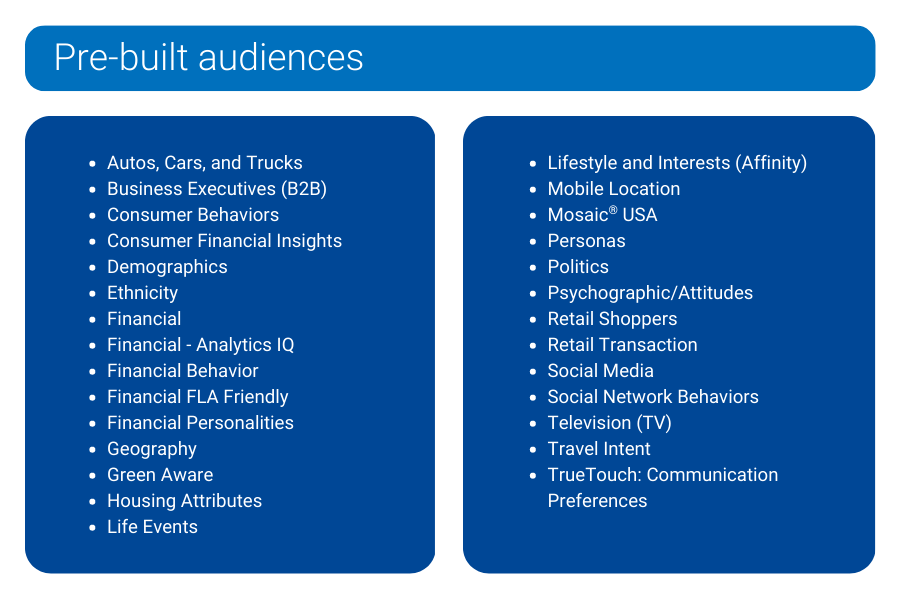
Mosaic® USA
Experian’s Mosaic® USA is a household-based consumer lifestyle segmentation system that classifies all U.S. households and neighborhoods into 71 unique types and 19 overarching groups, providing a 360-degree view of consumers’ choices, preferences, and habits. Using Mosaic lifestyle segmentation, you can anticipate the behavior, attitudes, and preferences of your best customers and reach them in the most effective traditional and digital channels with the right message in the right place at the right time.
Tailored Segmentation uses a sophisticated data-driven clustering system that leverages the 71 Mosaic types that match to first-party data like yours. Tailored Segmentation allows you to regroup Mosaic types based on the attributes you weigh as more impactful to your business. Have you designed your own segments in-house? You can apply Tailored Segmentation to those segments for deeper insights through a tailored analysis. Are you still looking for a way to segment your market even though you understand your typical best customer? Tailored Segmentation can weigh these attributes and develop a custom clustering and analysis of your market.
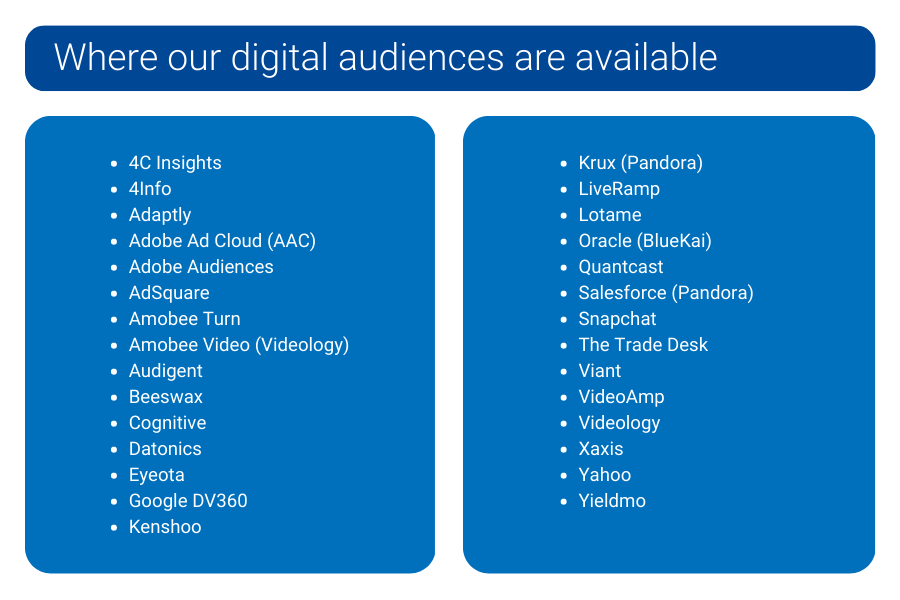
We can help you find your Super Users
Super Users are an important segment of any market. Marketers need to be able to identify them quickly and act upon their insights. Our marketing solutions provide the necessary data and analytical capabilities to easily find and target your potential Super Users for an effective marketing targeting strategy.
With Experian, you can deliver messages that are more in line with what matters to this influential group of customers. We understand how challenging it can be to find these customers and ensure they get the tailored, personalized messaging they deserve – so let us help you do just that! We can provide deep insights beyond the generic customer persona that allows marketers to look into the effectiveness of their marketing strategies from multiple angles. We want to help you gain an edge over your competitors by helping you identify, target, and engage Super Users for increased revenue growth. Ready to find your Super Users?
Sources
Activate Technology & Media Outlook 2023. Activate Consulting.
Latest posts

Public attitudes are more open and accepting of LGBT Americans today, and marketers are increasingly showing their support of their LGBT customers. Experian Simmons includes a measure of sexual orientation among non-Hispanic respondents of our National Consumer Study, the only known large probability sample syndicated study to include such a measure. In our 2012 LGBT Demographic Report, we looked at marriage and cohabitation habits, as well as income levels and discretionary spend of LGBT and heterosexual adults alike. This data helps marketers better understand and connect to the growing and already influential LGBT demographic and to benchmark important factors against the heterosexual population. A look into individual earnings and household incomes shows that lesbian women earn more than heterosexual women regardless of relationship status. Specifically, the typical adult lesbian woman personally earns $43,100 per year compared with $37,600 claimed by the average heterosexual woman. Furthermore, the typical household income of a married or partnered lesbian woman is $7,200 higher than that of a married or partnered heterosexual woman. Mean individual earnings and household income of women, by sexual orientation When it comes to individual income, gay and straight men may earn roughly the same amount, but married or partnered gay men personally take home nearly $8,000 more, on average, than their straight counterparts. Additionally, the average household income of a married or partnered gay man is $116,000 versus $94,500 for a straight married or partnered man. Mean individual earnings and household income of men, by sexual orientation Income levels are important to consider when targeting consumers, but more important is determining the amount of money they have left over after the bills are paid for non-essentials. Despite having higher incomes, some may be surprised to learn that lesbian women have only the same amount as heterosexual women to spend on discretionary items. Likewise, gay men have less than heterosexual men for non-essentials overall, even though their incomes overall are quite equal. This is mostly likely due to the fact that both lesbian and gay adults tend to reside in larger cities where the cost of living can be considerably higher. Interestingly though, when household size is brought into the equation, we see that gay males actually have more to spend on non-essentials per capita than straight men. Gay men, for instance, live in households that spend $6,256 per capita annually on discretionary spending, nearly $1,000 more than what the households of heterosexual men spend per person. For more demographic and attitudinal information on the trends among the LGBT population, download the 2012 Lesbian, Gay, Bisexual, Transgendered Demographic Report.

My Experian Marketing Services’ colleagues and resident data experts Bill Tancer and Marcus Tewskbury answered the above question for marketers during our recent 2012 Holiday Planning Webinar. The webinar recapped key 2011 holiday marketing results, plus featured trends, benchmarks and recommendations for a successful and profitable 2012 holiday shopping season. Here are a few cool facts: For the first time, last year’s Cyber Monday beat Thanksgiving Day as the busiest online shopping day of the year Facebook and Pinterest were the top traffic sources to the Experian Marketing Services Retail 500 Pinterest visitors most often went to etsy.com and amazon.com from the pinterest.com site Dynamic content in emails can drive up to a 70% lift in open rates Tying web, email and in-store promotions together enhances the shopping experience and improves sales The bottom line is that marketers need to understand where there customers are, when they are there, and what they are doing. Armed with that knowledge, you can deliver personalized and targeted holiday messages that are sure to make this shopping season merry and bright (and profitable!). View the webinar to learn more.

Even though most kids haven’t even completed their current school year, now is the time for retailers to start preparing their 2012-2013 back-to-school marketing strategies. I remember growing up as a kid in rural Massachusetts thinking about how “back-to-school” TV ads were so irritating. Back-to-school? In July? I’m not even half way through my summer vacation! Little did I know back then that marketers like to get an early start to the back-to-school sales season by planting seeds with their target audience and hoping those seeds grow into a healthy crop of new customers. This remains true today and planting season starts even earlier. The back-to-school sales season represents a huge opportunity for marketers. Here are some facts and figures that help quantify the size of the market: According to the National Retail Federation, consumers will spend approximately $70 billion on back-to-school merchandise. About $23 billion of this is spending by parents of children in kindergarten through 12th grade. The remainder represents spending by students starting or returning to college. All told, the back-to-school season is the second largest consumer spending event for retailers outside of the winter holidays. According to the U.S. Census Bureau, this year there will be over 55 million students enrolled in schools from pre-kindergarten through high school. About 56% of these students are in grades one through eight, 28% are in high school and 15% are enrolled in preschool or kindergarten. About one-third of households contain children under age 18. That translates to roughly 38 million households. The vast majority of these contain school-age children. The back-to-school season is not just about reaching kids in elementary school, middle school, junior high school and high school. Another 20 million students are expected to be attending college. That’s a huge opportunity to sell things like dorm room furnishings, electronic gadgets and computers, just to name a few. With every marketing opportunity come certain marketing challenges. It’s never easy. Marketers of back-to-school products face their own set of challenges when vying for the attention of parents of school-age children. Here are some specific examples: Who are my key targets and how can I differentiate my marketing message? Targeting a market that includes a vast array of families with contrasting attitudes, opinions, motivations, lifestyles and shopping behaviors is incredibly challenging. Not all of these families are working from the same shopping list. And not all of these families will respond to the same marketing message. Segmenting your market into finer target audiences is highly recommended. How should my marketing budget be allocated across multiple online and offline channels? You have multiple sales and marketing channels to consider. You don’t want to build a marketing plan without a well-defined strategy for reaching your best targets. For instance, moms have a greater propensity to have a smartphone compared to the overall adult population. Thus, marketers should then be thinking about integrating mobile applications into their overall strategy. What can I do to make my message stand out above the crowd? Put yourself in the consumer’s shoes. I’m sure some of you are parents with children in school or in college. It’s a very crowded and cluttered back-to-school marketplace with many, many retailers clamoring for attention. One idea for standing above the crowd is to start by identifying your existing customers who are most likely to have families with children. Then send them an email early in the summer with suggestions for fun things to do this summer season. This can be followed up later with an email campaign containing some tips about getting ready for back-to-school. The key is to grab their attention and start engaging early. What variety of offers and promotions will enable me to capture a significant share of back-to-school expenditures? To capture your fair share of the back-to-school market you’ll need to develop offers and promotions that are both enticing and relevant. This requires learning as much as you can about your prospects and what motivates them to buy. For instance, a typical mom with elementary school-age children might enter the back-to-school season with the following thoughts: “I want to buy him the cool gear to go back to school with: new clothes, shoes, backpack and lunch box. And I don’t mind, I actually LOVE back to school shopping.”* That mom may quickly respond to your marketing message. Or, you could have a mom with these thoughts: “I’m not upper class – we’re in the lower/middle income bracket and money is tight for us. I budget for school expenses as I would anything else…and I won’t have my son miss out because ‘we can’t afford’ something… I’d give up something else first.”* She loves shopping for back-to-school, she has budget limitations, and she’s willing to make certain adjustments to her budget with the best interests of her child in mind. If you knew what she was most likely to be thinking, do you think it would influence the messaging and offers you would use to attract her? Well, of course. Attitudes shape shopping behavior. ___________________________________________________________________________________ Watch our recent webinar about planning your back-to-school marketing campaigns in style. And stay tuned for part two of my blog series on the topic in a few days. *Feedback was compiled from PHD in Parenting: http://www.phdinparenting.com/2011/08/22/who-should-pay-for-school-supplies/